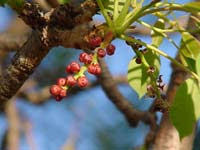.JPG)
The marulas are fruiting.
Marula fruits are about the size of a small plum. They have a tough skin over a litchi or grape-like flesh that clings tenaciously to the rock-hard nut. The fruits fall when they're still green and sour, but after a couple of days they ripen to yellow and fill with a delicious juice. Biting into a ripe marula is like gulping a shot of very sweet liquor. The taste is mostly just sweet, but also acidic - not surprising considering that they contain four times as much ascorbic acid (vitamin C) as an orange.
.JPG)
Everywhere the bush is carpeted with fallen yellow fruits.
Along the highway, troops of baboons sprawl beneath the roadside marula trees, lounging and banqueting like families on a Sunday picnic. Herds of impala gather in the trees' shade, tails flicking and cheeks bulging with the tell-tale lumps. They patiently grind the flesh away from the woody nut for about five minutes before suddenly expelling the nut like a champion cherry-pit spitter.
Marula fruits are about the size of a small plum. They have a tough skin over a litchi or grape-like flesh that clings tenaciously to the rock-hard nut. The fruits fall when they're still green and sour, but after a couple of days they ripen to yellow and fill with a delicious juice. Biting into a ripe marula is like gulping a shot of very sweet liquor. The taste is mostly just sweet, but also acidic - not surprising considering that they contain four times as much ascorbic acid (vitamin C) as an orange.
Female marula flowers
Marulas (Sclerocarya birrea) are one of the dominant tree species at my study site so my long-suffering mongooses have to cope with my constant slurping and munching as I follow them around. A single tree can produce more than 500kg of fruit each year. As the fruiting period only lasts around 3 weeks, it's impossible for the wildlife to consume so much fruit and most of it simply rots beneath the tree. When I first came to the lowveld, I was appalled at this profligate waste, and felt guilty that I wasn't busily cooking up marula jam or marula jelly or marula wine... But come my first winter dry season, I realised that the fruit wasn't wasted after all. When everything is dry and desolate, and all the vegetation has lost its leaves, the protein and oil-rich nuts are a life-saving staple for wildlife. When the baboons or wart hogs are feasting upon old nuts, you can hear the gunshot-like sound of cracking nuts more than 100m away.
The tree squirrels simply gnaw out the nut's kernel, through 2 or 3 'eye holes'. And they leave behind middens of empty husks that look disturbingly like someone has slaughtered a whole posse of small animals.
.JPG)












No comments:
Post a Comment